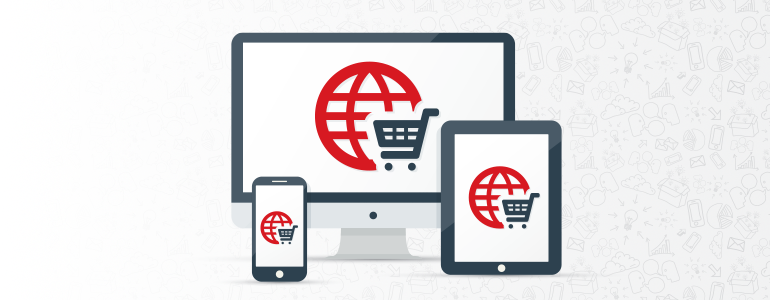New Online Advertising Rules in China
New online advertising regulation in China will impact all digital business with presence in China. Here we bring you an analysis overview to start adapting to the new trend in advertisement.
It would be after the death of a college student who took part in an experimental health treatment found in Baidu, when popular pressure would force the Government to begin an ads regulatory change.
The Internet Ad Interim Measures, a new regulation prompted by the State Administration for Industry and Commerce of China, went into effect in September 1st. Therefore, it arises from the Government’s claim by adopt new rules over online advertisement: email, paid searches, embedded links, images, and videos are already subject to the new law. Its aim is avoiding the spread of misleading advertisements on the Net, and correct the prevailing liberality so far.
The new online advertising regulations are expected to impact on Chinese Digital Marketing as a whole: social media, search engines, apps and electronic commerce in the country will have to move under the new guidelines.
A step closer to the uses and customs in Western advertisements
For the first time in China, the new measure features a specific definition of Internet advertising; often, foreigners suffer from a lack of legislative safety in China. Therefore, conceptualization is a step forward to define clearly not only the concept, but also its extension:
“Internet advertising is advertisements that directly or indirectly sell commercial goods or services through the websites, web pages, internet applications and other forms of Internet media including text, images, audio, video and etc.”
Moreover, the regulation comes to underline its main purpose:
“To protect the legitimate rights and interests of consumers, and promote the healthy development of the Internet advertising industry.”

In what fields are these changes applicable? What changes will take place after its implementation?
The regulation is particularly focused on a list of fields described below:
-Healthcare and medicine
-Food and beverage
The main measures to be starting to apply can be summarized as:
–First, the Law requires to place the word “advertisement” in a prominent position and clearly distinguishable at first sight.
–Second, every field subject of special regulation needs a previous review and an approval process by authorities.
–Third, online advertisements for prescription medicine is banned. A special measure in health products is also extended to medicines, pesticides or medical supplies.
–Fourth, tobacco online ads are also banned.
–Fifth, any paid search results, links or content must be clearly identified by the word “advertisement”.
–Sixth, users should not only have the choice to close an ad, but also this has to be easy to them.
–Seventh, paid links and contents must be clearly detailed at a glance.
–Eighth, any attached ad and/or promotional links to an email should have been allowed previously.
–Ninth, any misleading and/or false ad is considered illegal from now on.
Who is especially affected by the new regulation?
Under this measure, the biggest impact falls on the largest Internet companies in China. Baidu and Bing should apply new restrictions on ads; it should not be forgotten that, much of the incomes of Baidu, Weibo or Alibaba come advertising.

But also traditional Social Media must change. WeChat or Weibo offer paid content; as we mention before, pop-ups, ads or links should be first permitted, which will force companies to evolve the way advertising is offered to Chinese users. Seems marketers should start creating better ads, or contravening the prevailing legislation with all the penalties that that means.
There are plenty of creative ways to sell your services and products in China. In search of a Digital Marketing Agency?
Infographic: 10 Things You Need To Know To Build a Chinese Website
A picture is worth a thousand words
After the great success achieved by our two articles 10 Things You Need To Know To Build a Chinese Website (I) (II), in the team we have thought it would be a good idea to summarize and turn them into an infographic.
We hope you enjoy it as much as we enjoyed its elaboration 🙂
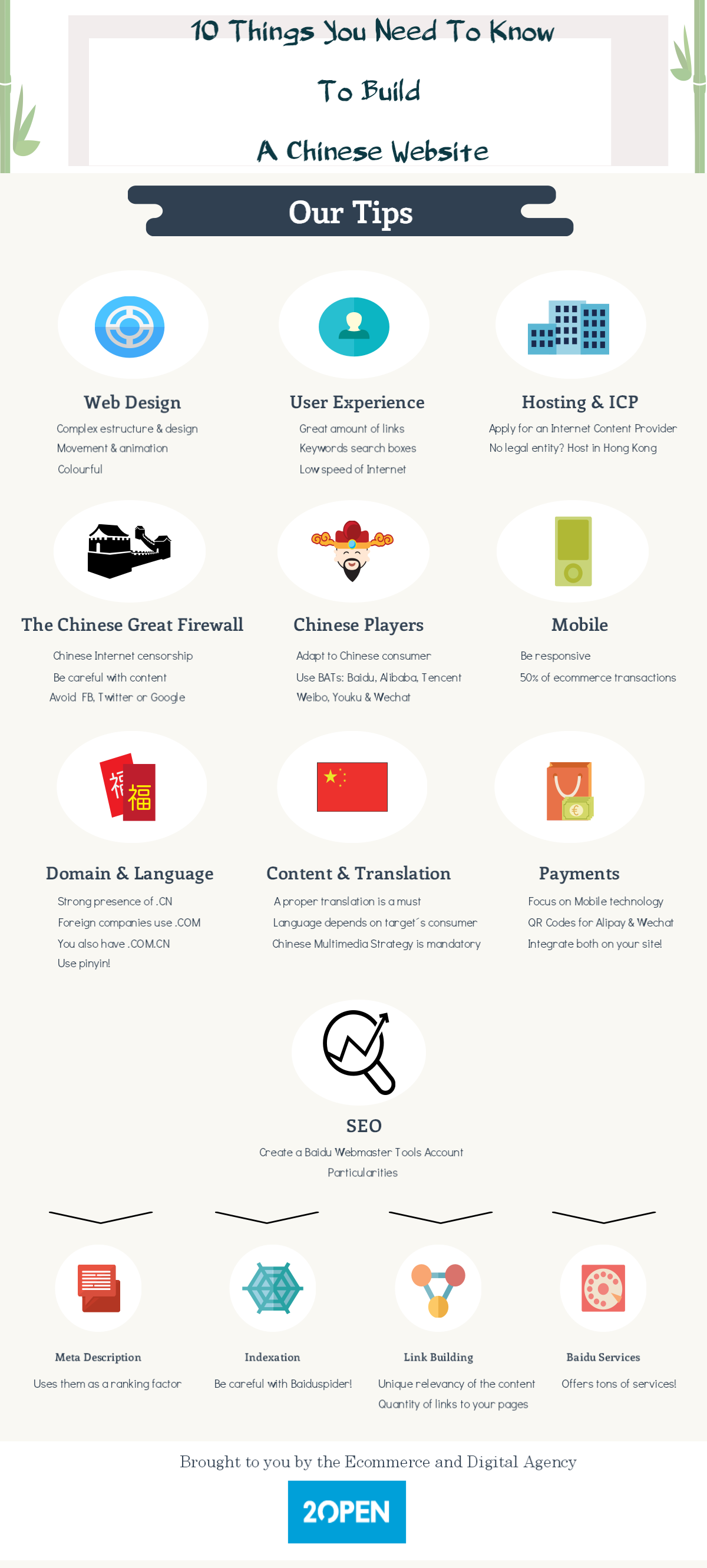
Are you looking for a digital marketing and ecommerce agency?
Visit us. Let´s have a talk!
Spain and China, Allies but not Colleagues in Trade
This post comes to underline the strategy played by Spain on EU’s China policy, a role which has received virtually no attention so far, as well as the major reasons why Spanish e-commerce is potentially attractive for Chinese companies.
Spain´s strategy is based on promoting a political resemblance with China in order to gain a preferential economic treatment, a plot which has led to disparate results for both China and Spain.
A general view of bilateral trade
Even though both countries feel friendliness each other, they do so for different reasons: Spain emphasizes on economic benefits, while China is interested on Spanish political weight on the European stage.
In the last thirty years, Spain has tried to turn China into a key-partner, with mixed results in practice.
- China is the 5th non-EU destination for Spanish exports
- China is the 1st non –EU origin of Spanish imports
- Spain is the 7th trade partner of China in –EU
- China is the 11th destination of Spanish exports
- China is the 14th destination for Spanish investment (less than 1% of total)
- Spain is the 9th destination for Chinese investment in -EU
When looking at the evolution, some positive trends can be underscore:
- Spain’s exports to China have double to 4 billion in 2014
- China’s exports to Spain are growing since 2013
- Both country´s exports are well diversified
After the financial crisis in the West, Spain has redoubled its efforts to trade with China. There is still a huge growth potential for both countries to further develop.

Political understanding to facilitate Chinese future investment
The difficulties encountered by the Spanish companies in their landing in China contrast with the political temperance shown by Spain in its approach to China. The policy marked by Spanish governments regarding its Chinese counterpart has never shown significant differences: whether the party in power, Spanish policy has always been the same.
Far from stagnating, Golden Visa and Spanish Treasury Bonds are just two examples shown by Spain to attract Chinese investors, as well as the constant reminder of its close ties in Latin America.

The potential of Spanish E-commerce: an opportunity for Ecommerce business
Comparing to other mature markets, there are still loads of fresh chances to seize in the country: Spain’s ecommerce market as a whole is relatively small.
According to the latest analysis –Ecommerce Europe ´14-, Spain is the largest Ecommerce market in Southern Europe, far from Italy (2nd) and Turkey (3th).
Around 60% of Spanish customers already shop online, spending on average € 900 per year. Moreover, more than the 60% transactions are cross-border: UE, US and China lead the Top-3.

Its growth potential can be prompted by some aspect anyone thinking on approaching Spanish ecommerce should take into consideration :
- Improvement in logistics
- Take an advantage of the lower cost for online marketing
- Customer acceptance of foreign W-shops
- Spanish consumers distrust on websites, so offering a secure payment method is a must. Paypal is the favorite of more than half of buyers
- Spain is the European leader in mobile usage, and keeps growing
- Spain is the best gateway to test Portugal and Latin American countries
The bilateral relationship between China and Spain is one of our tasks. Thanks to our understanding of the market, in 2 Open we can help you boost your digital business.
Leverage the benefits both countries offer to your company,
Visit us!
Is Latin America a Strategic Spot for the Chinese market?
Over the last fifteen years, Chinese Government has experienced an increasing attention on the possibilities that Latin American market can provide to them.
This article seeks to shed light on the current situation between both regions, and their future possibilities.
According to Chinese policy, in recent years the country has developed a new global strategy: Africa, Latin America and the Caribbean have become as key-players on its rise to the international scene.
Since 2000, China has settle its action on bilateral free trade agreements and loan commitments. Despite its evolution, the role assumed by China is yet far from a real partnership with Central and South America.
In future, commerce and investment will be the basis for establishing a lasting partnership and a socio-economic development in manufacturing, labor, services and financial support.
Which are the main factors that define their relationship?

The relationship is based on three basic purposes:
- Political Relations:
China has currently become a permanent observer in the Organization of American States and a member of the Inter-American Development Bank. The country also participates actively in the Economic Commission for Latin America and the Caribbean.
In addition, China has signed free trade agreements and institutional arrangements with some of the regional countries.
- Economic Relations:
China plays a leading role in the future economic scene in the region. Latin America exports to China are raw materials, such as minerals, ores, oil seed, meat, cooper and soybeans.
Economic Relations are mostly conducted by Chinese Public Sector: Trade, Investment and Financing enhance the mutual cooperation and the collaboration is constantly increasing.
The Chinese investment effort has been particularly strong in two important fields: Energy and Infrastructure.
- Cultural Relations:
Chinese cultural expansion is closely linked of their latest conception of International Relations based on pragmatism and soft power.
In recent years, many Confucius Institutes have started their activity in Latin America, but also Spanish language has experimented a huge growth in China: educational and cultural exchanges are on the rise.
Is there ROOM ENOUGH for a common trade based on high value-added?
Latin America suffers from a scarce innovative effort, while China struggles to turn its economic system into an innovation model, highly rooted in the high value-added.
ICT-based services, Information technology and also Ecommerce are expected to grow in Latin America. The Global trends in Crossborder Ecommerce will be a challenge to the international integration of Latin America and a great opportunity for MSMEs.
Are you already familiarized with Crossborder Ecommerce and B2B, B2C, C2C, B2G and C2B Models? In search of an Ecommerce Consultancy Agency?
From 2 Open we can help you develop your business and to boost your company into International Sales.
How to take advantage of the latest E Commerce revolution? U-Commerce trend
Nowadays, we all are very well aware of the importance of Ecommerce on current business.
E-Commerce has been a great revolution for companies and customers, helping the exchange of goods and services without geographical barriers via Internet.
With most of famous brands selling via e-Commerce and the development of B2B, B2C and C2C markets, the last revolution has come to stay: the Mobile Commerce or better known, M-Commerce.
But, What do we mean when we talk about M-Commerce?
The increase of the usage of smartphones and tablets and the growth of its capabilities, lead to a higher percentage of the population using technological devices to purchase their goods or services. According to the increase of the demand and in order to take advantage of this new trend, Companies have already identified the need to adapt their ways of selling to the portable devices.
China, the biggest consumer via E-Commerce country and a technologically advanced market, is a good example to put into consideration: the Retail and C2C ecommerce sales have grown from the 9% to the 55.5% since 2013.
This information show us that nowadays, most of the C2C Chinese customers prefer to use the mobile device than their PCs or laptops.
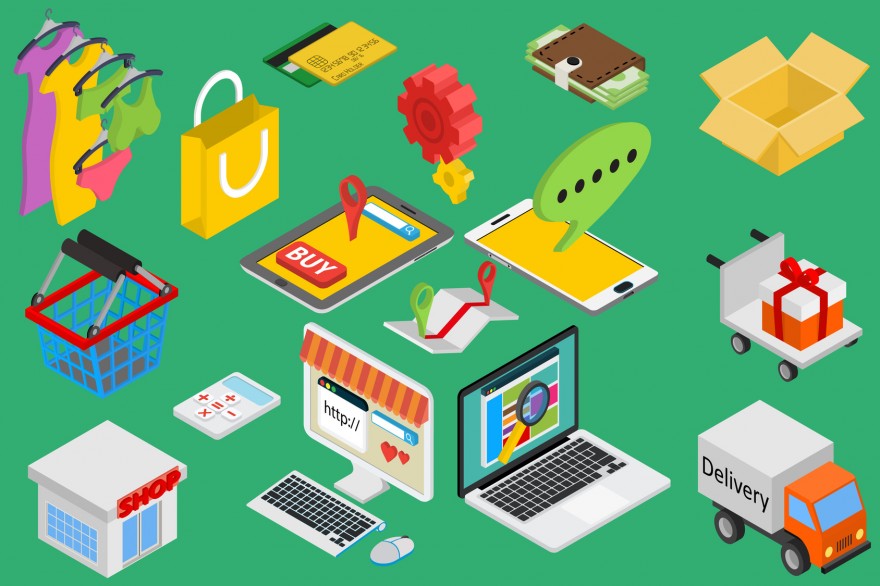
Omnichannel Marketing, What´s its purpose?
At the same time, to E-Commerce has joined a new feature: the existence of the multichannel approach to sales, or “Omnichannel”.
This channel is looking for the continuous shopping experience of each customer. The aim of the Omnichannel Marketing is offering a continuous experience to the user, independent from the device or channel chosen.
In practice, this leads to a complete integration between phones, tablets and computers and it requires the combination of an anthropological and technological strategy in approaching the users in a smarter way.
From the combination of all this, arises the U-Commerce concept.
What is U-Commerce or Ubiquitous Commerce?
If we simplify, we would say that we are talking about U-Commerce when E-Commerce is based in the customer experience.
The user must be in the center of all Companies’ strategies. Those Companies using U-Commerce must be able to provide personalized service to their clients from the information they get from mobile devices and PC-s.
The keys are: customizing and navigation experience created in cooperation with the User.
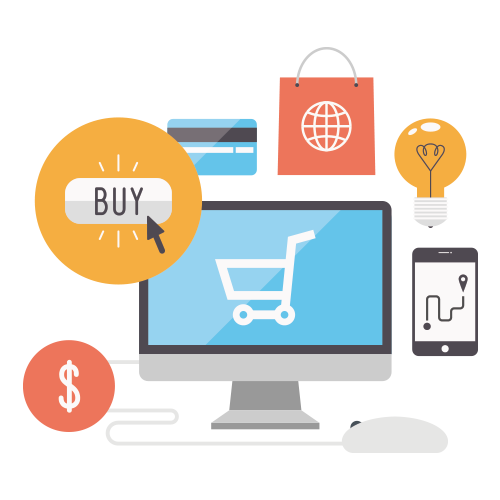
How is this possible?
It is obvious that the technological development is responsible for this change and makes necessary to pay attention to the internal customer databases.
Companies must try to find out common interests between potential clients who visit their EShops, considering each potential customer as unique and with their own preferences and priorities.
Efforts should be directed to avoid high rates of leads who finally give up navigating in the last purchasing phase, and reach around 60-70%.
This is the crucial reason for companies to invest their efforts and resources in understanding the customers and their behavior: to boost sales.
A lack of privacy: How companies use data?
U-Commerce uses personal information in order to provide a personalized service. A big number of customers feel disrespectful that a company can get their personal information and manage it as they want. Therefore, we must emphasize the benefits that the data can bring to the user and treat delicately the data we are able to collect.
Times are changing and the number of E-Commerce consumers is increasing exponentially and also the M-Commerce is growing very fast.
It’s important to face it and consider user’s needs, their preferences and desires. So companies must rechange strategies and adapt to the new eCommerce “revolution”.
Are you thinking about improving the user experience and exploit the advantages that the use of Online Marketing gives us?
Come to us, We are expecting you!
This article has been edited by Paula Vicuña, from 2 OPEN.
Tencent and JD Launch Targeted Brand Advertising on WeChat
From the association of Tencent –owner of the biggest social platforms in China- and JD.com –the leading online direct sales company in the country-, has emerged a new conception of Marketing and Brand Advertising.
In 2016 in Beijing, both released a plan based on Ecommerce marketing service called “J&T Plan”.
The new policy was aimed to provide a tool to accurate a better portrait of the potential user, and improve the interaction with the consumer.
As a result, users data has become extremely valuable for any company:
Knowledge is power, more than ever.
What are their main Goals?

The aspiration of Tencent and JD.com partnership has been to provide a pleasant and high quality service to their users.
To reach its purpose, they have focused on three main objectives to strength its business on mobile and Internet, such as:
- Mobile access points
- Traffic support
- Ecommerce activities
Their desire to turn the user into the protagonist of the new Marketing, has launched a new approach based on three main ideas:
- Multi-dimensional user insight
- Effectiveness analysis
- Precision target audience
What do they want in Return?

Not only a commitment to the future and an advantage over its competitors, their relationship also give them some specific advantages:
JD.com obtains a stake in Yixun, PaiPai C2C marketplace businesses, logistics personnel and assets and QQ Wanggou B2C.
On the other hand, Tencent will offer level one access points in Weixin and Mobile QQ and support from other key platforms to JD.com.
In order to provide a better online shopping experience, they will also work together on providing solutions to online payment services and an overall digital marketing solutions.
If you are thinking on improving your company services, before starting a Business and Marketing Plan you should take in consideration some basic recomendations:
Build a well-aimed portrait of the users, improve brand experience with the client, and enhance technological tools to achieve it, have become the three key factors to consider on any approach to potential customers, and the best guarantee for the future of your company.
From 2 OPEN we have conformed a team capable of responding to new challenges and specialized on Business Intelligence. We can help you to deal with the new Marketing and Ecommerce trends.
Come with us. Together we will reach your company goals.
This article was edited by Paula Vicuña from 2 OPEN.
How to Sell on Wechat?
Interested on learning how to sell on Wechat? Keep reading!
On 20 April 2015, China Press and Publication Academy launched their first report based on Wechat platform. With over 600 million potential customers, the Report showed the great potential Wechat has for Brands to reach new audiences in Chinese market.
WeChat is one of the most important Social Media platforms in China. Set out as a communication tool, its newest strategy has been launching the most successful mobile eCommerce platform nowadays.
For foreign companies willing to sell in China, take advantage of the benefits of using Wechat gives them the chance to enjoy its simple access to products by an easy way to pay, and also get advanced information of their customers. Its latest movements have become the app in a crucial tool to increase the consumer communication with brands and users engagement.
In order to continue adding value to our customers and launch a profitable business in China, we encourage you to go deeper on Wechat to take advantage of every opportunity that pops up in China environment.
What are the specific requirements to introduce a company on Wechat?
First, Create your Wechat Official Account:
Due to legal regulations, bear in mind that only Registered Companies in China are allowed to create their own Brand pages. Do not forget that in 2 OPEN we are authorized to apply for it!
Some are the steps you should be aware to create the account
- Fill the basic information to feature your products and services. After receiving an Email activation, configure your account.
- Choose the most suitable account type from the two options provide for the public interaction, specified in the list below:
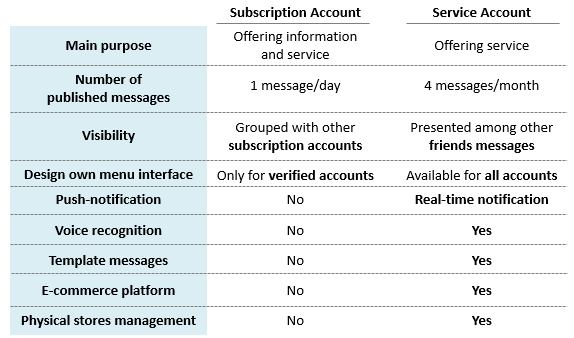
Sell on Wechat
- Once you are successfully registered, Wechat gives your company the chance to get more benefits and some interesting advantages to add value to your shop, like:
- Exclusive identifier
- Practical port
- Customized menu
- Account authenticity and security
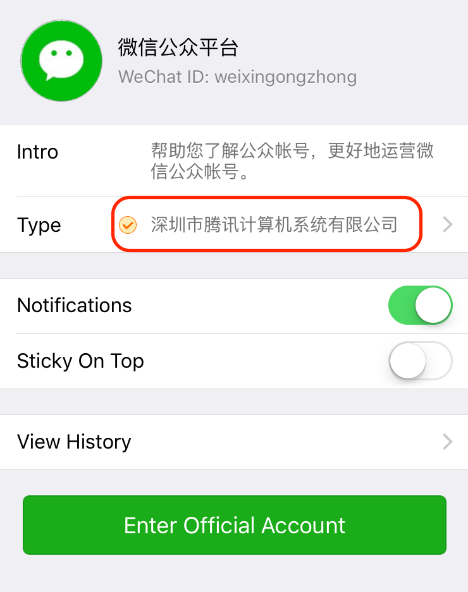
Sell on Wechat
Second, Third platform registration:
Although Wechat has its own shop, set one up via a third party platform can provide many interesting features, like:
- It is free and easy to add new items
- Gives the One-click sharing
- Contributes to faster transactions and better security on them
- Download a Mobile Ecommerce platform app according to your demands: To illustrate the post and due to the great importance of Weidan in China (微店), we will focus on it. Baked by Tencent, Weidan is based on social relationships with no centralized entry-point. It gives you the chance to post your products information across a wide variety of Social Media platforms with an ultra-streamlined registration and administration processes which make it easier to sell your services and products.
- You can create a new account or logo in your Wechat official account.
- Input your phone number to bond with the account, and the app will send a code to your phone to pass the SMS verification.
- Use the red-button to fully use the app
- Bind with your Bank-card to paying and collecting operations
- To set up your products, click on “My Products” and upload your product.
- Add pictures and fill the description, price and requirements of your products or services.
Third, Link Weidian with your Wechat Official Account:
From the back office, go to Customize Menu to edit the content in structure.
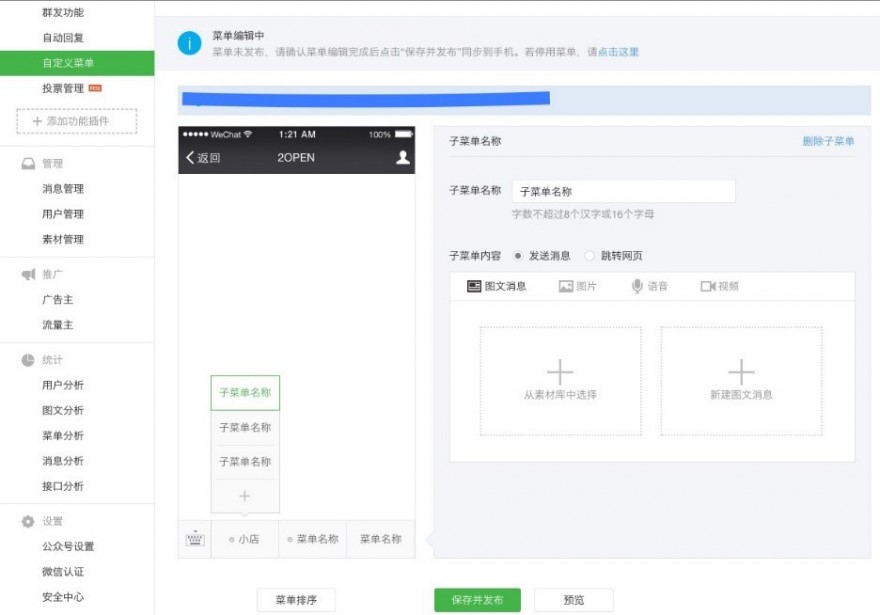
Sell on Wechat
Fourth, The final presentation to your Wechat account:
- Click the Bottom Menu (only in case you enjoy a verified account!)
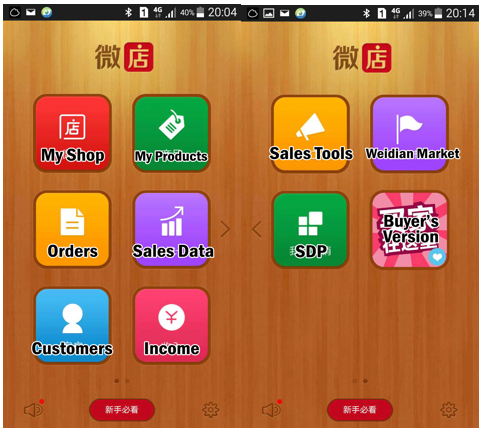
Sell on Wechat
- To get into the shop, you do reply the message. In latest version, when users enter the official account, an automatic message will present the options to follow the instruction to transfer into the Shop page.
And…done!
From the team we hope these tips will help you to understand further the latest trends in Chinese market.
At 2 Open we have the experience and knowledge to develop your business in China and become your guide to launch your business in Asia.
Still speculating about how to grow your business in China?
Get in touch with us!
This article was edited by Paula Vicuña from 2 Open.
Do other e-commerce platforms stand a chance against Tmall?
All of us are very well aware of the magnitude of the Chinese online market and, although it is currently the largest e-commerce market in the world, most of the market share is owned by the Chinese e-commerce giant Alibaba. Nevertheless, there are some other companies that also want their piece of the pie and with their vertical e-commerce platforms they are starting to put up a fight. This article will focus mainly on those vertical platforms that constitute an important part of the diverse Chinese e-commerce environment.
In the 4th quarter of 2015 China’s online transactions surpassed 644.38 billion RMB, the pie chart shown bellow contains the market share of the top ten Chinese e-commerce platforms:
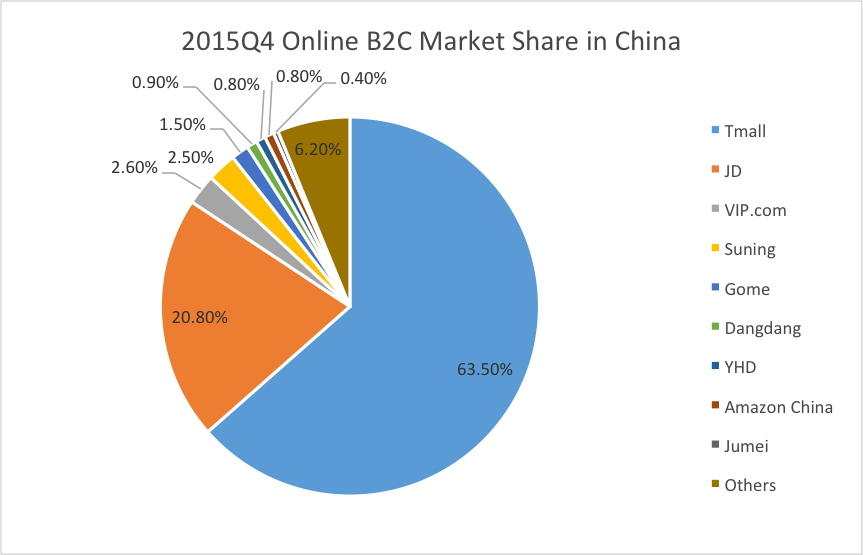
Before we continue, we first have to clarify the concept of vertical e-commerce. In this context, vertical refers vendors that offer goods and/or services that are specific to an industry or customers with specific needs. A vertical e-commerce platforms could be a independent brand or a specified category within a wide range of products such as clothes, 3C (computer, communication, and consumer electronics) products, cosmetics, etc.
If you already have a basic understanding of the Chinese e-commerce market, then you are probably familiar with JD.com. Currently the second e-commerce platforms in China after Tmall (owned by Alibaba Group), JD.com started as a 3C products vertical B2C website. Now, let us take a look at the market share of 3C products in China B2C online market:
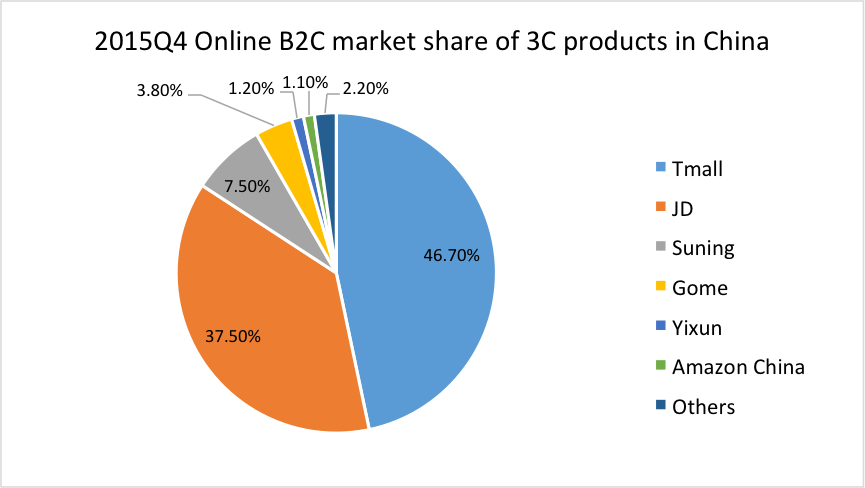
Although Tmall is still on the first spot, the difference in market share of JD.com is considerably higher than with regular products. Tmall and JD.com combined own more than 80% of the Chinese 3C products market. Suning, on the 3rd spot, and Gome, on the 4th, both also started specializing in 3C products, however, nowadays they have also diversified their range of products. At the end, it seems that there are no actual vertical platforms anymore.
To study the online market, we cannot miss the biggest category, clothes. In the 4th quarter of 2015, the total transaction of clothes is 235.57 billion Yuan, market share is shown below:
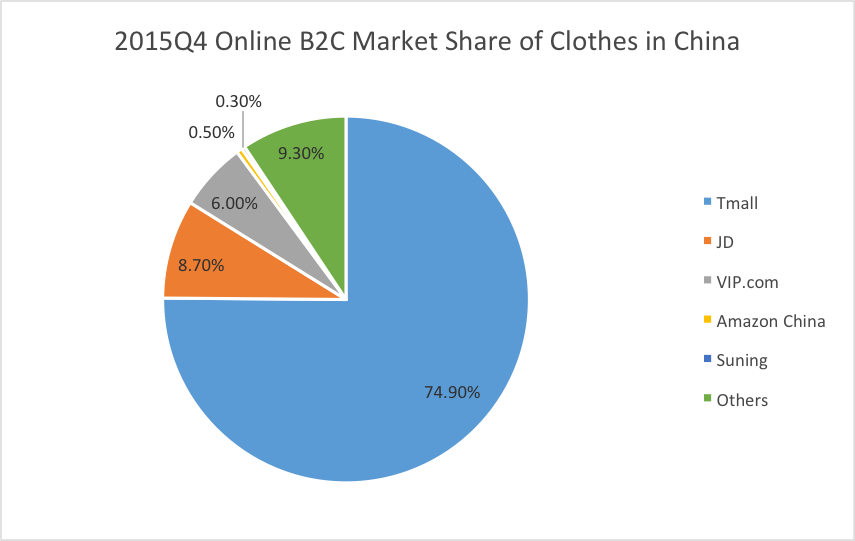
In this case, Tmall is leading with an absolute advantage of almost 3/4 of the market share. In this category, JD has 8.7% of the market share, VIP.com has 6%, and surprisingly others do not even have 1% individually, so from the big picture the vertical market for clothes is not active enough.
Another category that has had such a rapid growth we cannot ignore is the maternal and children products. Shown below is a pie chart containing China’s maternal and children products market share figures of major competitors in the last quarter of 2015:
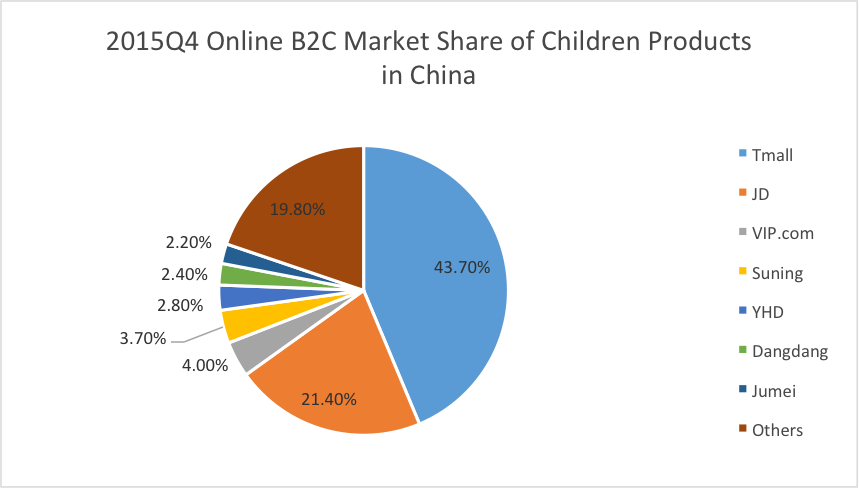
The most noticeable difference in comparison with other categories is the porcentage own by other platforms that adds up to almost 20 %. Although Mia, Beibei, Babytree and others are in that 20% it is still a big figure. In this category Tmall and JD.com own less than 70 % of the Chinese clothing market, so we can say, to some extend, that there is still space for vertical players.
The next category is books and, even though the books total transaction was just 5.31 billion Yuan, the market share gives us a slice hope of competing with general platforms, in this case Dangdang is leading with 43.8%, and Tmall is only on the 3rd spot, just after JD.com.
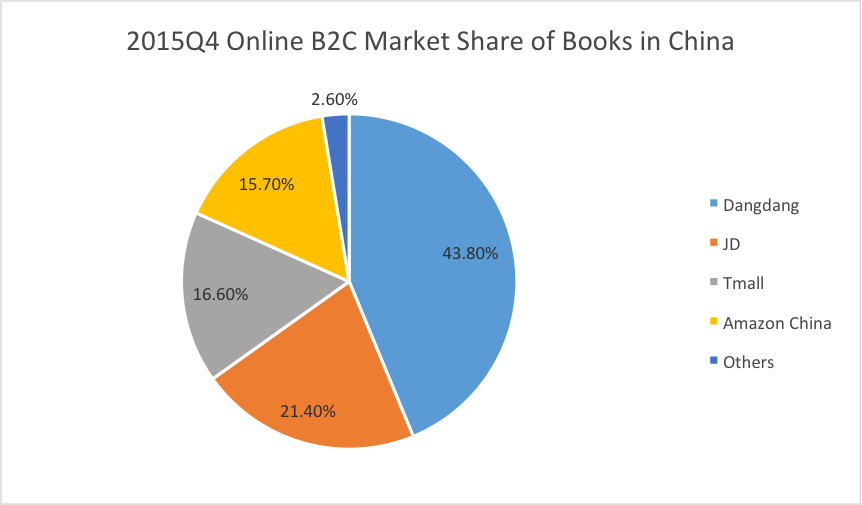
Finally, we cannot say all vertical online platforms are dead in China just because most of the categories are gloomy, there are still some worth a try, and you just need to know enough about the current situation. If you don’t, luckily you saw this article, and you know 2open can always help you to find the right channels. So don’t hesitate, contact us now!
All in all, even though Tmall dominates in the Chinese market, there is still space for other platforms to flourish. Vertical e-commerce platforms seem to be the wisest option, specify in a certain category, gather information about the current situation in the Chinese market, and carry out your business plan. If you need further information about the market, would like to help you find the right channels, or want us to set up your business in China, do not hesitate in contacting us. Our group of specialists will happily assist you.
This article was edited by Andres Arroyo Olson from 2 Open.
References.
All products data from
http://www.analysys.cn/yjgd/17684.shtml
3C data from
http://www.analysys.cn/yjgd/17676.shtml
Clothes data from
http://www.analysys.cn/yjgd/17678.shtml
Children products data from:
http://www.analysys.cn/yjgd/17680.shtml
Books data from:
All you need for your Chinese Landing Page
Landing pages have become more and more relevant over the past few years. With an increase in brand awareness and persuading power, they play a huge roll when it comes to online marketing and ecommerce. This article will focus on the basic structure of a successful landing page as the improvements that can be made to achieve better results.
What is a landing page?
Landing pages are often called guide pages, in general terms, a landing page is the first page that appears when a user enters a website, this could be either the homepage, product page, about us page etc. The channels through which the user enters the website are in most cases clicks on advertisements or results or search engines. There are a few things a landing page has to achieve and although it depends on its business scope, their aims can be simplified in the following way:
-Invite users to keep visiting
-Lead users to make a purchase
-Get users’ personal information
-Invite users to share or to comment
-Other activities, which can bring interactions, etc.

What does a landing page consist of?
Usually a landing page consists on 4 main parts:
- USP (Unique Selling Proposition)
- Core media
- Detail explanation
- CTA (Call-To-Action)
- USP (Unique Selling Proposition)
This is what we call “selling point”. In China, a lot of companies consider this as their core competence. It is a way of distinguishing yourself from other competitors; this is where a company presents its most attractive features about the products or the services it provides. It should basically answer the question: Why should consumers hire my services or purchase my products instead of the others in the market?The main headline of the landing page is also of great importance. It should be a sentence that explains your USP and it should attract the users’ attention. It is basically the first thing users read when they arrive in your landing page so therefore it must be concise and catchy.
- Core media
Media has been used to enrich a landing page, making a page more attractive through the use of pictures and videos or animations.When people are watching a webpage, an interesting picture or video can leave a better impression than a sentence.
- Detail explanation
This is a main part of your landing page. Here you need to put more detailed information to support your USP. It could be points that further explain in a more detailed way the main value proposition of your service or product. It could also include advantages of what your are providing the customer as well as useful real life examples that will continue to support your USP.

- CTA (Call-To-Action)
This is the deal-sealing part of your landing page. It should not be difficult for a customer to complete the purchase of the service or product at any given moment whilst he/she is viewing your landing page. It does not matter if it is a button, a link, or a form; you just have to make sure that it is obvious and eye-catching. Users must know exactly what they are doing on your webpage and all the relevant information that comes with it, both monetarily and logistically.
To sum up
We might take for granted the elements of landing pages, consumers do not really notice all of the work that has been put into a webpage, but as long as you would like to have a successful one, you should pay better attention to these details and think on creative ways to improve them. Nobody starts from the top, so why not give it a try and see how a good landing page can benefit your business?
If you have any questions or require any information about our services, please do not hesitate in contacting us, our group of specialists will happily assist you.
This article was edited by Andres Arroyo Olson from 2Open.
References:









